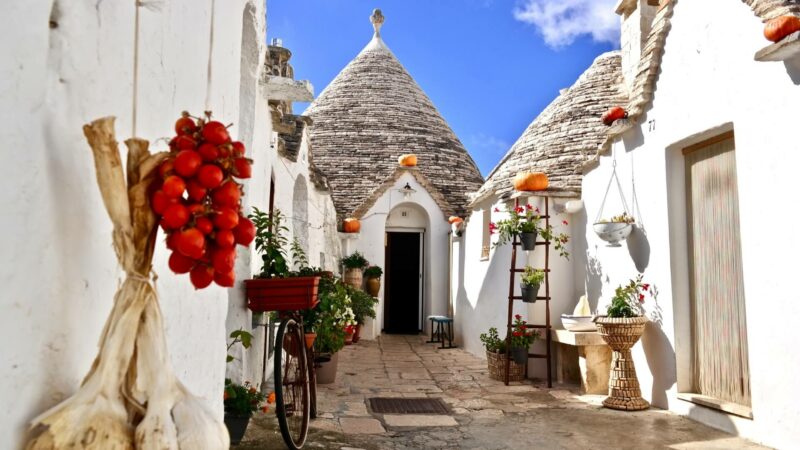The tranquil Lombardy of lakes and valleys
To grasp the remarkable artistic heritage and beauty of Lombardy’s diverse territories, one simply needs to tour its lakes where peaceful and drowsy towns lie. For instance, after inspiring Dante, Goethe, Stendhal, and D’Annunzio, Lake Garda, whose waters caress Lombardy, Veneto, and Trentino, is now beloved by travelers for its slow living and amusement parks. Did we mention spas such as the famous ones in Sirmione, fashionable even in Catullus’ time? This land presents biodiversity: the shores of Trento exude the charm of Norwegian fjords, while the Lombard shore enjoys a Mediterranean climate. Lake Como, a favorite haunt of celebrities for its shores dotted with lavish villas, offers an immersion in art and nature straight from a boat or ferry. You will explore the center of Como (the city of silk and Alessandro Volta), with the medieval Piazza San Fedele, the late-Gothic Cathedral, and the neoclassical Villa Olmo. Then you arrive in Bellagio to dip your gaze in the bright green vegetation and the magnificence of the homes with water gardens that even captivated Napoleon.
In Varenna, a fishing village, tranquility and calm intertwine among chapels, shops, and the Lover’s Walkway, an arched promenade where plants and flowers hold hands. Lake Como also includes Lake Lecco: named due to its shape resembling a Greek lambda (λ), it is divided into two branches, as described by Alessandro Manzoni in The Betrothed. Above Lecco lies the Valtellina, a destination for trekking and skiing enthusiasts. It is a culinary cradle of the region thanks to pizzoccheri (pasta with cabbage, potatoes, and stringy cheese). Another typical dish is the polenta taragna, where buckwheat mixes harmoniously with butter and the ancient Bitto cheese. Then there is bresaola, a lean yet flavorful cured meat. Lake Iseo is a treasure trove of natural reserves and picturesque villages: the romantic Lovere, the sporty Predore, and Sulzano where relaxation and sailing are the winning combination. And now, by boat (or ferry) to Montisola, a magical land with a triple nature: mountain, lake, island. All around, surrounded by marshes and herons, the welcoming wineries of Franciacorta, renowned worldwide for their sparkling wines, await you in the vineyards for an aperitif.
The Lombardy with heart in the province
If Milan is the pulsating heart of Lombardy, getting there is a crescendo of heartbeats that animates the smallest but most delightful ‘provincial towns.’ Cremona, the capital of music, attracts you like a violin solo. Among the medieval architectures, you will find the Violin Museum with unique pieces signed by Stradivari. All around are windows with the typical nougat, and the workshops of the master luthiers whose ‘Know-how’ is a UNESCO heritage. Festive harpsichord arias resound in the enchanting Mantua, born between the curves of the Mincio river. Here the Gonzaga family made it a Renaissance center of primary importance, embellishing it with the Ducal Palace. It houses the Bridal Chamber frescoed by Mantegna, and Palazzo Te, where the Hall of the Giants dominates. In Bergamo, on the other hand, you can sample a guitar and piano duet, in honor of its dual nature. Embraced by the Venetian walls, the Upper part is a late medieval jewel box of arcades, alleys, courtyards, and shops surrounding Piazza Vecchia, with the Cathedral and the Palazzo della Ragione. The Lower Bergamo, elegant and on a human scale, shows wide avenues and squares with stately palaces from the 1920s and the Donizetti Theater, while Botticelli, Raphael, and Titian are displayed in the neoclassical building of the Accademia Carrara.
Finally, to the increasing rhythm of the drums, here you are in the capital. Milan can also surprise you as an art city thanks to iconic monuments such as the Cathedral – with its walkable spires- and the golden statue of the Madonnina, symbol of the city. The Sforzesco Castle, commissioned by the Sforza family in the 15th century is another stunning example of ancient architecture. Milan is home to the most renowned universities, headquarters of banks, newspapers, insurance companies, and corporations, with a widespread historic center. The Vittorio Emanuele Gallery, built in neo-Renaissance style, is a succession of boutiques and restaurants. The Teatro Alla Scala is one of the most coveted opera stages in the world. A quadrilateral of streets represents the realm of high fashion. Brera is the “artists’ district,” where the Art Pinacoteca, local bars, art and design shops make the cultural atmosphere effervescent. But Milan also reveals a path with the footsteps of the artistic and engineering genius Leonardo da Vinci; his masterpiece The Last Supper, is a famous painting created in the refectory of the convent of Santa Maria delle Grazie. His hands are also noticeable at the Navigli, home of the reborn Darsena ancient “port,” which made Milan a river city akin to Manhattan. The Navigli has now returned to being one of the vital nocturnal ventricles of the Milanese heart that beats around the clock. Milan, cosmopolitan by nature, also offers ethnic and oriental cuisine, but its culinary essence is found both in the kitchens of starred chefs and in the bistros and taverns of the Navigli. Traditional dishes include saffron risotto with veal marrow, veal cutlet, cassoeula (braised savoy cabbage with all parts of the pig). The capital is also the kingdom of the aperitif, a rite of 19th-century tradition, when the flourishing production of spirits and liqueurs made it famous worldwide. And finally, an honorable mention to Panettone. The origins of this “Toni’s bread,” with raisins and candied fruit, seem to derive from a mistake due to a romantic distraction by the cook of the Sforza family. It is a sweet, soft bread with a particularly slow fermentation, Milanese in origin but transformed later into the sweet symbol of Italian Christmas.









